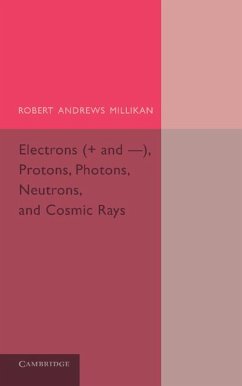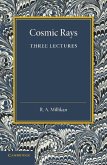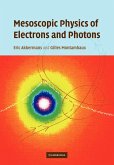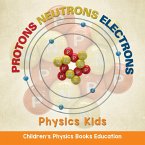Robert Andrews Millikan
Electrons (+ and -), Protons, Photons, Neutrons, and Cosmic Rays
Robert Andrews Millikan
Electrons (+ and -), Protons, Photons, Neutrons, and Cosmic Rays
- Broschiertes Buch
- Merkliste
- Auf die Merkliste
- Bewerten Bewerten
- Teilen
- Produkt teilen
- Produkterinnerung
- Produkterinnerung
Originally published in 1935, this book was written to provide an accessible guide to developments in physics.
Andere Kunden interessierten sich auch für
![Cosmic Rays and Mesotrons Cosmic Rays and Mesotrons]() H. J. J. BraddickCosmic Rays and Mesotrons30,99 €
H. J. J. BraddickCosmic Rays and Mesotrons30,99 €![Cosmic Rays Cosmic Rays]() R. A. MillikanCosmic Rays42,99 €
R. A. MillikanCosmic Rays42,99 €![Mesoscopic Physics of Electrons and Photons Mesoscopic Physics of Electrons and Photons]() Eric AkkermansMesoscopic Physics of Electrons and Photons80,99 €
Eric AkkermansMesoscopic Physics of Electrons and Photons80,99 €![Electrons at the Fermi Surface Electrons at the Fermi Surface]() SpringfordElectrons at the Fermi Surface86,99 €
SpringfordElectrons at the Fermi Surface86,99 €![Protons Neutrons Electrons Protons Neutrons Electrons]() BabyProtons Neutrons Electrons17,99 €
BabyProtons Neutrons Electrons17,99 €![Simplified Method Of Tracing Rays Simplified Method Of Tracing Rays]() Simplified Method Of Tracing Rays18,99 €
Simplified Method Of Tracing Rays18,99 €![Cosmic Reality: Understanding space, time, and Einstein's universe Cosmic Reality: Understanding space, time, and Einstein's universe]() Vrushank AgrawalCosmic Reality: Understanding space, time, and Einstein's universe19,99 €
Vrushank AgrawalCosmic Reality: Understanding space, time, and Einstein's universe19,99 €-
-
-
Originally published in 1935, this book was written to provide an accessible guide to developments in physics.
Hinweis: Dieser Artikel kann nur an eine deutsche Lieferadresse ausgeliefert werden.
Hinweis: Dieser Artikel kann nur an eine deutsche Lieferadresse ausgeliefert werden.
Produktdetails
- Produktdetails
- Verlag: Cambridge University Press
- Seitenzahl: 512
- Erscheinungstermin: 2. Juni 2014
- Englisch
- Abmessung: 203mm x 127mm x 30mm
- Gewicht: 610g
- ISBN-13: 9781107689213
- ISBN-10: 110768921X
- Artikelnr.: 44263616
- Herstellerkennzeichnung
- Books on Demand GmbH
- In de Tarpen 42
- 22848 Norderstedt
- info@bod.de
- 040 53433511
- Verlag: Cambridge University Press
- Seitenzahl: 512
- Erscheinungstermin: 2. Juni 2014
- Englisch
- Abmessung: 203mm x 127mm x 30mm
- Gewicht: 610g
- ISBN-13: 9781107689213
- ISBN-10: 110768921X
- Artikelnr.: 44263616
- Herstellerkennzeichnung
- Books on Demand GmbH
- In de Tarpen 42
- 22848 Norderstedt
- info@bod.de
- 040 53433511
Introduction
1. Early views of electricity
2. The extension of the electrolytic laws to conduction in gases
3. Early attempts at the direct determination of e
4. General proof of the atomic nature of electricity
5. The exact evaluation of e
6. The mechanism of ionization of gases by x-rays and radium rays
7. Brownian movements in gases
8. Is the electron itself divisible?
9. The structure of the atom
10. The nature of radiant energy
11. Waves and particles
12. The spinning electron
13. The discovery and origin of the cosmic rays
14. The direct measurement of the energy of cosmic rays and the discovery of the free positive electron
15. The neutron and the transmutation of the elements
16. The nature of the cosmic rays
Appendix A. ne from mobilities and diffusion co-efficients
Appendix B. Townsend's first attempt at a determination of e
Appendix C. The Brownian-movement equation
Appendix D. The inertia or mass of an electrical charge on a sphere of radius a
Appendix E. Molecular cross-section and mean free path
Appendix F. Number of free positive electrons in the nucleus of an atom by Rutherford's method
Appendix G. Bohr's theoretical derivation of the value of the Rydberg constant
Appendix H. A. H. Compton's theoretical derivation of the change in the wave-length of ether-waves because of a scattering by free electrons
Appendix I. The elements, their atomic numbers, atomic weights, and chemical positions
Appendix J. Physical constants
Indexes.
1. Early views of electricity
2. The extension of the electrolytic laws to conduction in gases
3. Early attempts at the direct determination of e
4. General proof of the atomic nature of electricity
5. The exact evaluation of e
6. The mechanism of ionization of gases by x-rays and radium rays
7. Brownian movements in gases
8. Is the electron itself divisible?
9. The structure of the atom
10. The nature of radiant energy
11. Waves and particles
12. The spinning electron
13. The discovery and origin of the cosmic rays
14. The direct measurement of the energy of cosmic rays and the discovery of the free positive electron
15. The neutron and the transmutation of the elements
16. The nature of the cosmic rays
Appendix A. ne from mobilities and diffusion co-efficients
Appendix B. Townsend's first attempt at a determination of e
Appendix C. The Brownian-movement equation
Appendix D. The inertia or mass of an electrical charge on a sphere of radius a
Appendix E. Molecular cross-section and mean free path
Appendix F. Number of free positive electrons in the nucleus of an atom by Rutherford's method
Appendix G. Bohr's theoretical derivation of the value of the Rydberg constant
Appendix H. A. H. Compton's theoretical derivation of the change in the wave-length of ether-waves because of a scattering by free electrons
Appendix I. The elements, their atomic numbers, atomic weights, and chemical positions
Appendix J. Physical constants
Indexes.
Introduction
1. Early views of electricity
2. The extension of the electrolytic laws to conduction in gases
3. Early attempts at the direct determination of e
4. General proof of the atomic nature of electricity
5. The exact evaluation of e
6. The mechanism of ionization of gases by x-rays and radium rays
7. Brownian movements in gases
8. Is the electron itself divisible?
9. The structure of the atom
10. The nature of radiant energy
11. Waves and particles
12. The spinning electron
13. The discovery and origin of the cosmic rays
14. The direct measurement of the energy of cosmic rays and the discovery of the free positive electron
15. The neutron and the transmutation of the elements
16. The nature of the cosmic rays
Appendix A. ne from mobilities and diffusion co-efficients
Appendix B. Townsend's first attempt at a determination of e
Appendix C. The Brownian-movement equation
Appendix D. The inertia or mass of an electrical charge on a sphere of radius a
Appendix E. Molecular cross-section and mean free path
Appendix F. Number of free positive electrons in the nucleus of an atom by Rutherford's method
Appendix G. Bohr's theoretical derivation of the value of the Rydberg constant
Appendix H. A. H. Compton's theoretical derivation of the change in the wave-length of ether-waves because of a scattering by free electrons
Appendix I. The elements, their atomic numbers, atomic weights, and chemical positions
Appendix J. Physical constants
Indexes.
1. Early views of electricity
2. The extension of the electrolytic laws to conduction in gases
3. Early attempts at the direct determination of e
4. General proof of the atomic nature of electricity
5. The exact evaluation of e
6. The mechanism of ionization of gases by x-rays and radium rays
7. Brownian movements in gases
8. Is the electron itself divisible?
9. The structure of the atom
10. The nature of radiant energy
11. Waves and particles
12. The spinning electron
13. The discovery and origin of the cosmic rays
14. The direct measurement of the energy of cosmic rays and the discovery of the free positive electron
15. The neutron and the transmutation of the elements
16. The nature of the cosmic rays
Appendix A. ne from mobilities and diffusion co-efficients
Appendix B. Townsend's first attempt at a determination of e
Appendix C. The Brownian-movement equation
Appendix D. The inertia or mass of an electrical charge on a sphere of radius a
Appendix E. Molecular cross-section and mean free path
Appendix F. Number of free positive electrons in the nucleus of an atom by Rutherford's method
Appendix G. Bohr's theoretical derivation of the value of the Rydberg constant
Appendix H. A. H. Compton's theoretical derivation of the change in the wave-length of ether-waves because of a scattering by free electrons
Appendix I. The elements, their atomic numbers, atomic weights, and chemical positions
Appendix J. Physical constants
Indexes.








